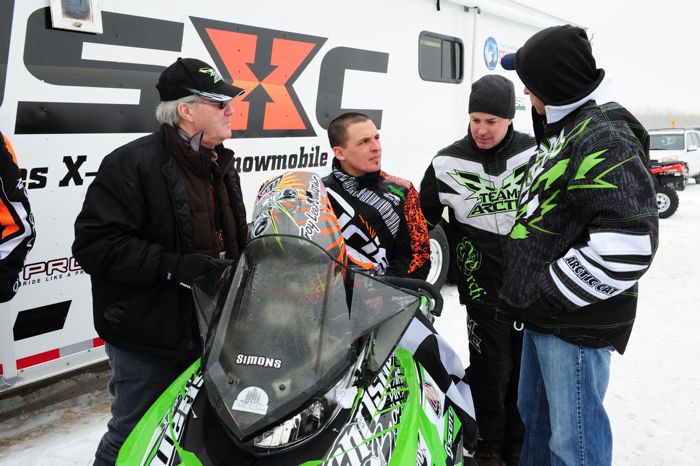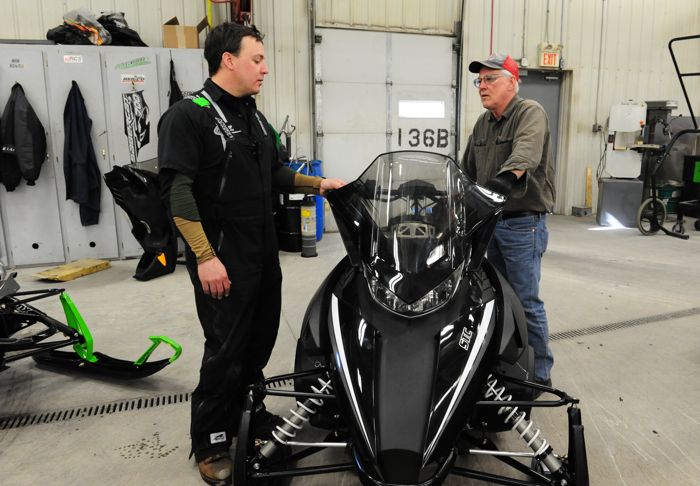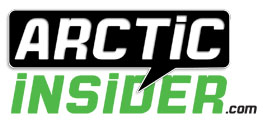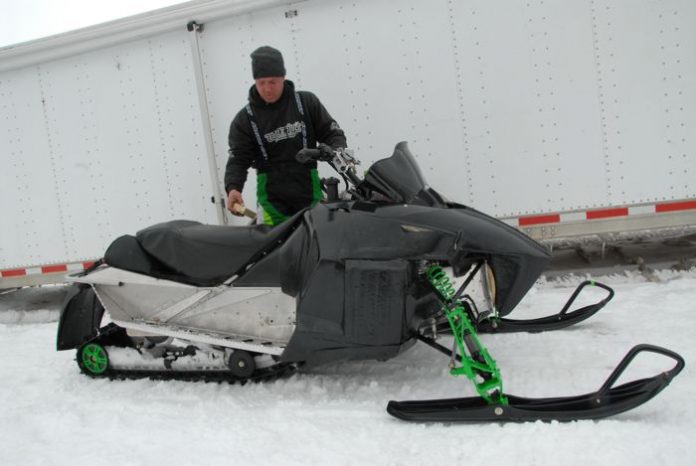
Cut from the same cloth as Kirk Hibbert, Larry Coltom, Roger Skime and many others, Arctic Cat’s Brian Dick blends equal parts “racer” and “engineer” in his role as High Performance Product Team Leader.
In Part I of the interview, he discusses the tough moments in his 2013 race season; what he and Arctic Cat have learned via racing; and his effort to bring more R&D effort into the upcoming race season.
AI: It’s been two years since your last interview, so let’s catch up with a couple things. First, give me a quick rundown of your new job and what you do in that role?
Dick: Last winter I transitioned to the High Performance Product Team Manager role. The machines in this category include all Arctic Cat ZR models, XF 137-in. and ZR Sno Pro race sleds.
In a nutshell, I work with Manufacturing, Engineering, Purchasing and Quality to ensure that these current and future snowmobiles meet the expectations of our customers. In this role I organize schedules, test plans, fabrication and development of the sleds I mentioned. The role is very organizational, like I’m the hub of a wheel that includes those other areas and departments.
Fortunately there are a lot of great people in my department who help me with these tasks, which frees up time for my other responsibility: assisting with research and development (R&D) of new product.
The R&D role includes brainstorm meetings on new ideas, technology and products, as well concepting and testing this engineering. I’d been involved with R&D for several years and I want to continue with it. It’s important to be involved with product development from the ground up. All the Arctic Cat managers do this to some degree, because we all have a passion for it. As a bonus, I have a little more leverage now that I’m the High Performance manager.

Brian Dick (R) with Arctic Cat engineers Roger Skime (middle) and Bart Magner.
AI: How did that job change affect your racing season last year?
Dick: The biggest change… (Pause)… I was more focused on racing prior to this new job. Racing was an integral part of my job. Now, as manager, my responsibilities are broader and are more focused on our consumer machines, which means less time for racing. It didn’t affect my racing much last year because the job transition took place during the winter. This year will be bigger change.
I will still be at many races and competing in cross-country, but the racing effort will be focused on R&D rather than my own personal success. I used to go out with a stock sled with goal to win races and the championship. Now, maybe I’ll do some stock racing, but my primary focus will be doing R&D in Pro Open class, as well as testing and set-up development of our consumer ZR6000 El Tigre in the new Super Stock class [the new USXC Super Stock class is for consumer machines, not pure race sleds].

Brian won two of the three Pro 600 finals at the three USXC ice races early in the 2013 season. This shot was taken in Willmar, Minn., where he beat teammate Zach Herfindahl in the stock final.
AI: Cool, I think this will be great for Arctic Cat and its customers.
Dick: For sure, as we’ll make an even stronger connection between our racing efforts and our consumer machines.
AI: Okay, a couple questions about last race season: In the Iron Dog last year, you and teammate Eric Quam were running up front and challenging for the win until a broken component on each sled ended your race. What happened?
Dick: We were doing great, just a few minutes behind the leaders, until we failed driven shafts on both of our sleds. The first occurred on Eric’s Sno Pro 600 race sled about 60 miles from the last layover, which was about 300 miles from the finish. I towed him in to the layover stop, at which point we were still in second place.
We swapped a new shaft the next morning while on the clock, and then headed out on the racecourse. We made it another 160 miles, about halfway to finish, when the driven shaft failed my sled.
Eric then towed me to gas station, where we ate some sub sandwiches and drank a pop. While we were there word came through the radio that a rider on another team had been injured out on the course, so Eric went back out on course to help them. That was really cool.
In both instances the shaft broke behind top sprocket in chain case. It was pretty disappointing of course, but we also learned from it and we’ve instituted a new design and manufacturing process for the driven shafts on all of our race and consumer sleds.
But in general it was a disappointing ending to a race that, up to that point, had been really fun. We were the only Arctic Cat team up front, with about five or six Ski-Doo teams on our ass, which was exciting.

Two-thirds through the first leg of the 2013 USXC I-500, Brian was in the lead and breaking trail (the latter of which would contribute to a DNF 20 miles after this photo was taken).
AI: Yeah, that was heartbreaking. As long as we’re talking about disappointments, you started last year’s USXC Seven Clans Casino I-500 last year as a favorite to win, as well as the defending champ from 2011 (there was no race in 2012 because of weather conditions). On the first day you were smokin’ fast and leading the race when you experienced sled problems. What happened there?
Dick: Sheesh, what is this, pile-on-Brian day? (Laughs) Yeah, I burned the engine down before the finish on the first day.
We had a lot of fresh snow that first leg. Once I passed Gabe Bunke for the race lead, I was breaking trail, which is a heavy load on the engine. Combined with too-heavy clutch calibration and too-lean jetting, my race went from great to bad.
But again, this was another learning experience that we incorporated into our 2014 ZR Sno Pro race sleds. With a different exhaust pipe wrap, new clutch calibration and revised venting, we have a more forgiving sled for those heavy-pulling conditions.
AI: What have you learned with the Sno Pro race sled the past couple years that is applicable to the consumer sleds we ride?
Dick: Obviously the consumer Sno Pro RR package comes right out of our Sno Pro cross-country package that we build. The shocks and calibration are identical.
We’ve taken a lot of the brake components from race sleds and transitioned them to the consumer sleds for a better feeling brake. Plus there are some tweaks we’ve done on front suspension that have been incorporated into the consumer machines.
I think you’ll see more crossover in the coming years, which is one of the reasons why my race effort will be focused on R&D and consumer sleds.
AI: You’re one of the few people in the world who have put a lot of seat time on both the Sno Pro race sled and consumer machines like the ZR6000 El Tigre. Describe the similarities and differences in how they ride, handle and feel.
Dick: From a rider’s cockpit area like the seat, handlebars and rider position, they’re very similar. If you jump between our ZR Sno Pro race sled and our ZR6000 RR, they feel nearly identical.
Yet there are some differences of course. The carbureted 600 R engine in the race sled is built for racing, so it’s more powerful. Without oil injection, it’s also lighter (no oil tank). So the combination of more power and less weight is something you feel.
The race sleds also have a slightly wider ski stance, which gives the sled a little more stability. They come with C&A Pro skis, which are more aggressive.
One thing that’s certain, the new C-TEC2 600 engine with DSI is a far more enjoyable engine than the race engine, in terms of operational ease, consistency and of course emissions.

L-to-R: Arctic Cat’s Roger Skime, Ryan Simons, Brian Dick and Mike Kloety, following Simons’ win in the USXC I-500.
AI: What are your racing plans and goals for this coming season?
Dick: I attend as many races as I can, both snocross and cross-country, to gather info, talk with our racers and, in the XC events, race myself. I’d like to be prepared to compete at first USXC race of the year, but after that it gets a little less certain.
I’m also committed to race the race Iron Dog again this year with Eric Quam.
And I intend to support the Christian Brothers Racing team at the Soo I-500 enduro. Whether I’ll be racing or not is yet to be determined.
In addition to those commitments, I will work closely with Team Arctic racer Wes Selby, who we just hired for a part-time role in Engineering, as well as other racers to run in the Pro Open Class and Super Stock class.
Finally, I’ll probably race the USXC I-500 on an Open class sled.
AI: Of all those intentions, what are your priorities?
Dick: My priority right now is Iron Dog. It’s the one full commitment for which I’ve been given a clear green light. Eric and I will race production sleds, so that’s a big motivator.

Brian talks with Arctic Cat racer-engineer (and legend!) Larry Coltom.
AI: Production sleds! ZR6000 RR or ZR7000?
Dick: We don’t yet know. There are a lot of factors to consider.
Eric hasn’t yet ridden a 7000, so we’ll get him on one and see what he thinks. Plus there’s the strategy of which sled will be easier and quicker with the fuel stops. The 7000 runs on 87 octane, which is what’s available, and it probably gets a little better fuel mileage. Plus there’s no time wasted adding oil. Finally, no team has ever won the Iron Dog on a four-stroke sled, so that’s motivating. Whether all of that is more important than the 40-50-lb. weight difference compared to the ZR6000RR, we’ll have to see.
I talked with Team Arctic racers Ryan Simons and Cory Davis last night about this very topic. They’re racing the Iron Dog together and are wrestling with the same decision. Whatever the decision is, both teams will probably run same sleds.
For many of the same reasons, we’re not sure which sleds we’ll run in the Soo 500 either. That race is a little different animal though because we can run modified engines. Right now Speedwerx [the Team Arctic motor builder] is working on both the C-TEC2 600 and 7000-series C-TEC4 engines to help bring some clarity to the decision.
Editor’s note: Look for the full story about Brian’s 2013 Iron Dog sled prep in the coming days.
This concludes Part I of the interview with Brian Dick. More to come, soon.
Thanks for reading!



I have visited with Brian on a few occasions, great guy. Arctic will keep going strong with folks like him running the show.
FWIW, i would run the SnoPro 500 in the Iron Dog, then you know you have a proven combination, even though they don’t have the top end speed of the larger sleds, they would be tough to beat IMO.
One of the main reasons I’m staying on Cat is the fact they seem to be going back to race sleds(I know there are differences) that people like me can buy off the showroom floor. Brian Dick is a class act guy. I used to pretend I was him when iwas running the same Firecat as he was running out on the trails(and I was 23 haha).
The stress they must be feeling right now trying to solve the pro cross issues has to be overwhelming.
Cat does not have a lot of experience in trying to resolve a complete breakdown of an entire line up. Skidoo and polaris have bounced back from total complete failure and I’m sure cat can too. Yamaha is a lost cause in the industry but I think that if these two put their heads together the future will be great.
Flintstone, that’s a completely exaggerated characterization. There is nothing even remotely close to “complete breakdown of entire lineup.”
“Total complete failure” ???? There’s no way to take a statement like that seriously.
Like Ski-Doo and Polaris as you mention, Cat is responding to isolated problems with some customers on certain models. This has been standard operating procedure for every brand since the invention of the snowmobile, motorcycle, automobile, smart phone, etc…
Yes, there have been some problems. And that’s a disappointment, for sure. But the vast majority of ProCross/ProClimb owners have experienced no problems.
Ask a dealer what the percentage of their customers have had a problem. It’s single digits (unless they sold a pile of Turbos to customers who then boosted them).
Again, it bites that there are any problems and I’m not suggesting that problems are okay.
The measure of a company experiencing problems is how they respond.
Thanks for a great story John. Seeing Brian last year mop up at Willmar, then throw his sled in the back of his pickup for the ride back to TRF was classic.
Wow. I’m glad I don’t live in Flintstones distorted view of the snowmobile world. You been drinking and commenting again? Bad combo my friend.
Yeaba Daba where’s my brew ?! Wilma !!!!!
I am one of the riders that had a procross F800 that ate belts,broke jack shaft, had the tri hub wheels fail and lost an engine because the belts took crank seal. I will say Cat fixed every issue I had and my dealer was great. It did ruin a few trips of mine before I learned to take a back up sled. I do now own a new procross XF8000 137 because I thing Cat has fixed most issues. Polaris denied problems with the Fusion. Keep up the good work Brian. Hope you have a season with great success. That should also ensure I have a dependable sled this time around.
That was great! I really enjoy reading about the Iron Dog and how their race went. This year will be really exciting with so many top XC guys from the lower 48 coming up to compete. On paper the 4-stroke seems like the sled to run in the race but nobody really fast has taken the chance. Maybe this year will be different?
I visited my dealer just last weekend and we discussed some of the issues that had popped in the last couple of seasons looking for his input on my 2013 XF 800 and there were actually very few sleds out of their shop in 2012 that had issues, and they had no issues with the 2013’s.
Running stock consumer sleds in XC is the best R&D and advertising you can do. No B.S. when you win. Instead of catchy tunes and smooth talking, show us the trophies and checkered flags. Win on Sunday, sell on Monday!
If anybody wants to pay my repair bill on my 12 when I go to pick it up in 2014 after it is updated enough so I can ride it with a little bit of confidence let me know!!!
Hi I have been working with a dealer in the north east with a concern on my 2018 zr rr 8000 I have bleed green all my life CAT ONLY I purchase only high performance sleds if its a race thrue the trails then I am untouchable,i could care less for quarter mile its just boring to me but road course I am in as far as running against 850 doo or poo I have all the faith in my 880 c tek it rips and leaves so far all 850s in my dust so super excited about cats c tek 800 but there is a on going issue in my neck of woods the good ole north east so BRIAN DICK please respond to this e mail privately and maybe you me my dealer who are all hard core drivers and pure cat guys can get togather run these 800 c teks in my neck of woods and play a little (UNLESS YOUR SCARED) WHO WOULD NOT LIKE TO RUN A TRAIL WITH THE BEST. Bring TUCKER with you lets get my problem figured out togather you guys can stay rite at my camp free on me.i am 58 years young and own a Ford Dealership so I am not some punk kid.
misprint above statement just noticed 880 c-tek its a 800 c-tek obviously you no this no I did no mods to it